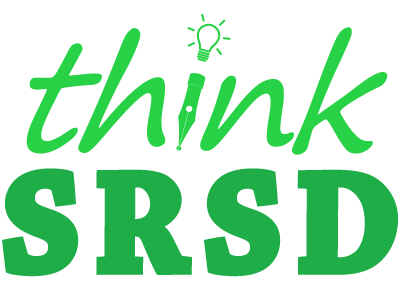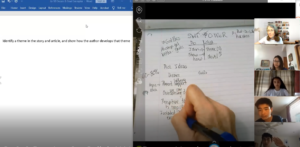SRSD Goes Virtual!
Well – I’m guessing none of us had worldwide pandemic on our 2020 Bingo card, but here we are! Since many of us are gearing up for full or hybrid virtual instruction, here are some tips to keep SRSD #GoingStrong!
Get Ready – Aim for students to have:
- Writer’s notebook (marble = our favorite) for note-taking, jotting self-talk, TIDE planners etc
- Folders for saving anything printed (stories, articles, exemplars etc)
- Pencils
- Highlighters (or crayons, colored pencils) – pink, green, yellow and orange
- Books, lots of books (Writers read, a lot!)
- Devices
- Bandwidth – many towns are starting to offer this free
- Printers – wish list item – and here’s why:
Printers? Yup! Research shows that when students read off paper, their comprehension is significantly higher. For SRSD, this would include close reading stories/articles, but also close reading peer-written exemplars. We want students to deeply understand what peers do in these exemplars. Reading and marking up paper copies will deepen their experience. If we can’t get printers, then send home packets with rich short stories, articles and many peer exemplars.
Include Parents
Have students explain POWeR & TIDE to their parents. They can watch this new video together. You could also just send this video (it’s on Youtube) to parents so they understand how you are teaching the writing process.
Mix Screen & No Screen Time
Too much time on screens is not healthy, or optimal for learning. Teach as much from paper as we can. From this angle, writer’s notebooks are everything. Have students write their self-talk, stop & jots and go through the steps of POWeR on paper in these. It’s ok to type up their essays in shared google docs, but keep planning on paper. If students cannot type yet, then have them write their pieces in their notebooks.
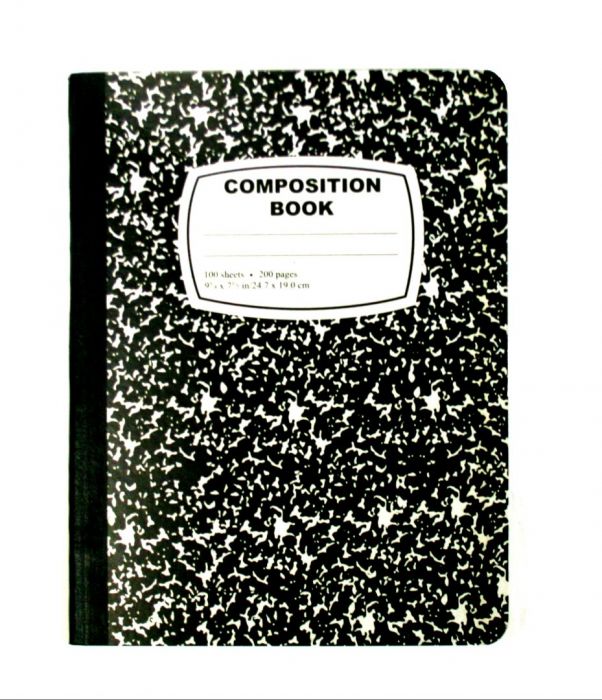
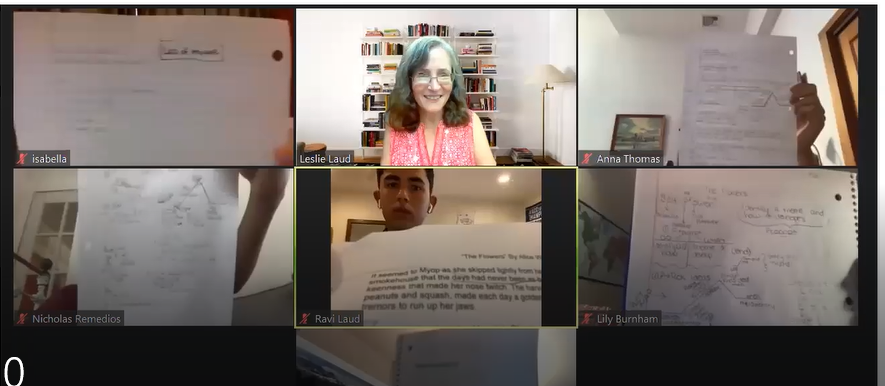
But – how will we see what students are writing? A few options:
Ask parents (or students) to take phone pics of what they wrote in their notebooks easy day, and send those to you or put in shared folders.
Have all students hold up their notebooks, say cheese, then you take a screen shot, as you see my students doing in this picture on left.
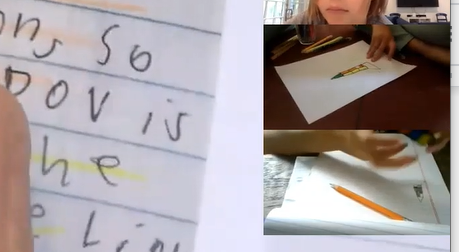
Students can also tilt laptops down as they work so you can see their writing or note taking happening, as they go!
Look closely at left picture. The students hands are visible, and their notebooks. They became skilled at doing this whenever it was notebook note-taking or writing time.
Even Better : Have students make a webcam projector using their phones and a USB cord. (Note: You can do this too when you want to project what you are writing!)
Again, look closely – there is a phone propped up over the soup cans, then connected via usb to computer.
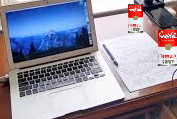
I use my phone as a web camera to project my paper when I write. On the left, you see my projected ‘full screen’ with part webcam projecting my writing as I go, and part of a google doc projected at same time.
Pro tip: Don’t use Zoom option “content from 2nd camera” – just share your full screen. This way you can show a word doc at same time as you project live writing happening.
Now Let’s Go Over the 8 Routines
Climate / Pre-assessment
To build climate, pick the most engaging tasks you can. Our students had fun with critical media analysis (Standard 7) – looking deeply at how commercials persuade. Their favorite was how a popular Doritos commercial did this. We paired this with an age-appropriate grade level text on critical media analysis from Scholastic.
For kids, being socially isolated was tough so we gave extra attention to fostering an upbeat climate. We opened every class with jokes or good news (idea from Matthew Kay) – tailored to the age groups taught. Our Gr 3 students enjoyed these jokes:
- What do you call a dinosaur who is sleeping” dino-snore
- Why didn’t teddy bear eat desert? Stuffed
- What is a witch’s favorite subject in school? Spelling
Next we had everyone greet the group by renaming themselves as a food they love or typing in warm hellos to a shared google doc that everyone was invited to:

Routine 1: Exemplars & Tools (Color Coding)
Shake it up: Color code on paper and project as you go, in word or in paint. Use a different mode each time to keep it varied and interesting. If using paint (or color coding on paper and projecting that), you can make a sentence both orange and yellow, and also or like to circle strong words. Paint (or paper) gives more flexibility.
Ensure students have printed copies of the exemplar or at least have their own electronic copy on their own screen. Students merely watching you is not ideal.
To keep them physically engaged – go on a scavenger hunt to find colored objects. Hold up your object to show the color you think each part is. Our students used bananas, and one even gently lifted her orange Tabby cat!
Students can also have fun with virtual backgrounds to show the colors! See below we had some who believed a sentence should be yellow, and some believed it was orange.
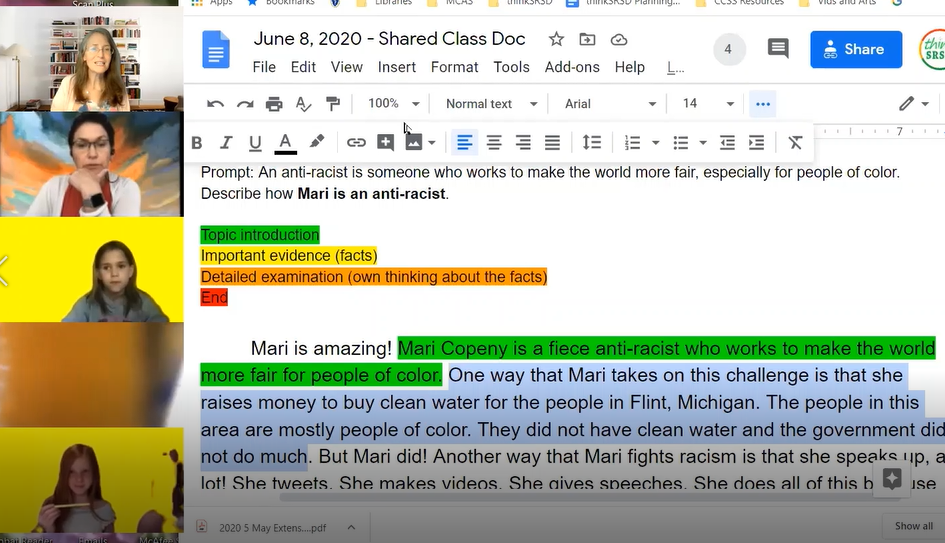
Color code in breakout rooms, then return and report out.
Tip: Students can learn how to screen share in breakout rooms
Memorize Mnemonic
Have students review mnemonic by:
Type mnemonic parts into chat
Write in notebook & hold it up
Un-mute and say it together
Detour Ahead – Drive around this! They know more than us! Things can go awry! Disable screen annotations and chat (private and full group) until learning agreements become norms. See below for a ‘spill in aisle virtual teaching on Zoom’ 🙂
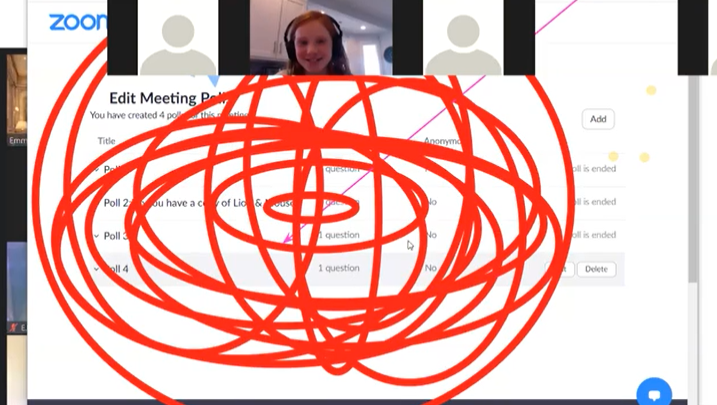
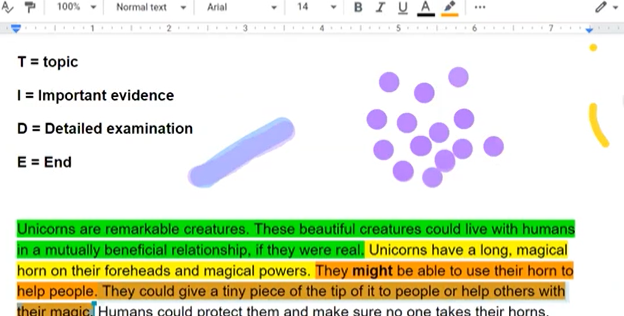
Routine 2 – Plan & Organze
Backward maps – have students do this standing near paper taped (blue tape is inexpensive and won’t harm walls) to wall. Remember our students still need to stand a lot. They need more than just regular breaks. Integrate ways into your lesson for them to stand.
Make sure they back map as you model this, virtually. They should be engaged with pencils going at all times (or typing).
Routine 3 – Revise & Edit
This routine (revision) has been one of our main go-to activities all through virtual teaching. Since we cannot monitor writing in the same way virtually, we have not been able to catch issues as early as we can when walking around our classrooms. However, when I do get to look over the writing at end of class, I see where students struggle and model exactly that in next class opening during a quick revision lesson. Revision became a quick opening mini lesson that took just 5-10 min at start of class, as in this video.
Routine 4 – SELF–TALK!!
Self-talk is always the heart of what we do. And during this time at home – never more so! We opened and closed every class with self-talk. Students wrote it in their notebooks, shared it in breakout rooms, watched videos on self-talk (many news ones over at Youtube thinkSRSD channel now!). We varied it up every day, but it definitely got far more emphasis, and will moving forward too. In this lesson, we made T charts of self-talk. The full version of this video (and many, many more) is on twitter (@thinkSRSD on Twitter)
*If you are not on Twitter, I can’t recommend it highly enough! It’s become my main source of Professional Learning. @thinkSRSD @leslielaud

At the end of class, students would share what self-talk they really used via chat, breakout rooms or holding notebooks up. Self-talk was explained to parents and students were encouraged to use it at home. One student shared how he used it to help him manage his irritation with his siblings when he wanted his room to himself so he could write. My older students shared how they use self-talk to trick themselves into believing they can do well, then it came true.
We’ve all heard reports of families facing far more stress during this pandemic, and this stress will impact our students. Use self-talk to help our students cope not just with writing, but with life as well.
Creative options:
- Find their heroes using self-talk
- Use padlet or make memes and store this in a shared online space
Routine 5 – Think Alouds
My think alouds got a whole new energy when done virtually. I began to pre-record my think aloud before class, then play it. This way you can watch your students’ faces and reactions as they watch. Be sure to still have them take notes, and share those in breakout rooms. Use a fun ‘thinking bubbles’ virtual background when you lead it, as you see behind me here. I pre-recorded this before class with Zoom (free), but Loom has a free version too. Screencastify is easy to learn and works well for this too.

Routine 6 – Collaborative Practice
Again Shake it up. Use different modalities. Keep students active. Students can generate ideas on Whiteboards, shared Google docs, in breakout rooms, and vote on them in polls. I fill in the Zoom poll template as my students generate ideas, then we vote! If you don’t have Zoom, this also works with google survey.
Polls were always a favorite part of our lesson.

Routine 7 & 8 – Scoring, Set Goals & Peer Score
All students can enter their scores as they evaluate an exemplar as a class or in a small group. See below – this can be done in real time. I initially used polls, but then we did not know who voted which way so discussions weren’t as easy.
Don’t agree with what the class thinks? Fine! Put your own score in the column with your name. Just be ready to explain why you gave it.
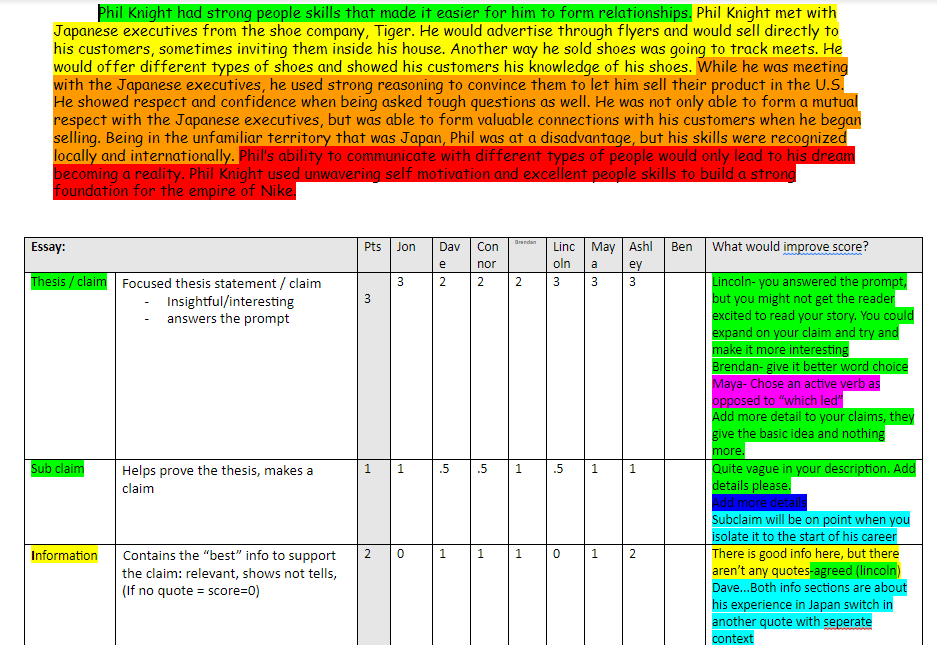
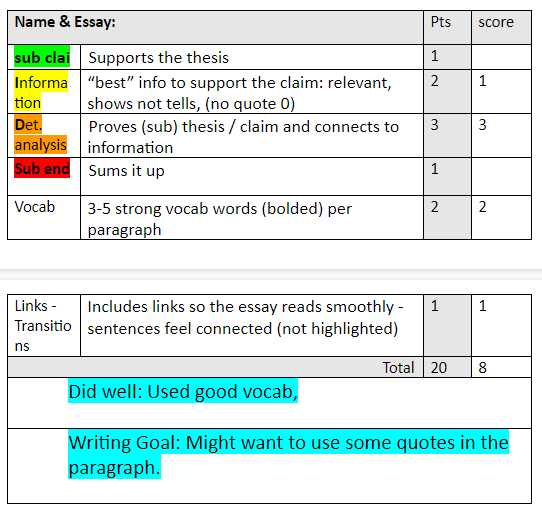
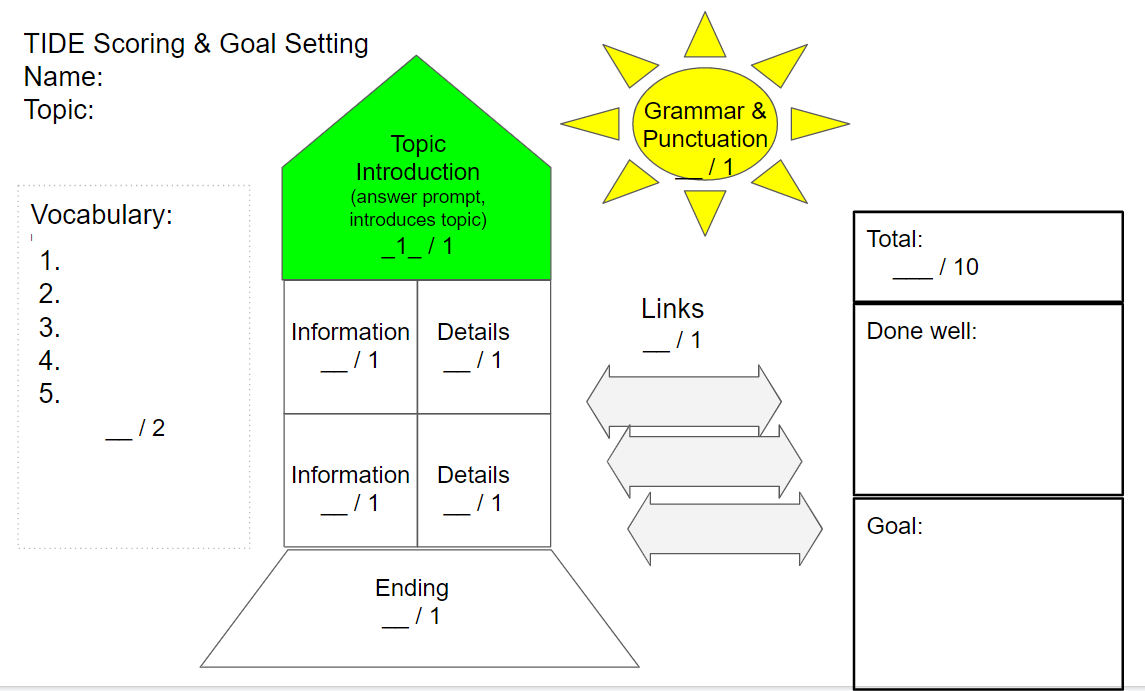
Parting Thought
Don’t get overwhelmed. Many schools seeing some of the highest gains have been using minimal technology all along. Don’t get overwhelmed feeling you need to learn everything tech that is new. Keep it simple. Use good pedagogy. Breathe. We can still love our students and can build good relationships even if through screens. Focus on pedagogy and loving our students – let the tech lightly support this core work, but don’t center the tech. Center the pedagogy and letting your students know how loved they are. Good luck!
*If you’d like to dive even more deeply into how to teach SRSD virtually, consider attending our webinar on Aug 3, 2020 from 11:00 – 12:00 EST: http://thinksrsd.com/events/
